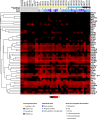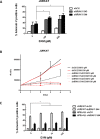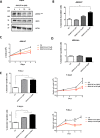Targeting IRAK1 in T-cell acute lymphoblastic leukemia
- PMID: 26068967
- PMCID: PMC4662467
- DOI: 10.18632/oncotarget.4150
Targeting IRAK1 in T-cell acute lymphoblastic leukemia
Abstract
T-cell acute lymphoblastic leukemia (T-ALL) represents expansion of cells arrested at specific stages of thymic development with the underlying genetic abnormality often determining the stage of maturation arrest. Although their outcome has been improved with current therapy, survival rates remain only around 50% at 5 years and patients may therefore benefit from specific targeted therapy. Interleukin receptor associated kinase 1 (IRAK1) is a ubiquitously expressed serine/threonine kinase that mediates signaling downstream to Toll-like (TLR) and Interleukin-1 Receptors (IL1R). Our data demonstrated that IRAK1 is overexpressed in all subtypes of T-ALL, compared to normal human thymic subpopulations, and is functional in T-ALL cell lines. Genetic knock-down of IRAK1 led to apoptosis, cell cycle disruption, diminished proliferation and reversal of corticosteroid resistance in T-ALL cell lines. However, pharmacological inhibition of IRAK1 using a small molecule inhibitor (IRAK1/4-Inh) only partially reproduced the results of the genetic knock-down. Altogether, our data suggest that IRAK1 is a candidate therapeutic target in T-ALL and highlight the requirement of next generation IRAK1 inhibitors.
Keywords: IRAK1; T-ALL; kinases; therapeutic target.
Figures





References
-
- Bassan R, Hoelzer D. Modern therapy of acute lymphoblastic leukemia. J Clin Oncol. 2011;29:532–543. - PubMed
-
- Bandapalli OR, Schuessele S, Kunz JB, Rausch T, Stutz AM, Tal N, Geron I, Gershman N, Izraeli S, Eilers J, Vaezipour N, Kirschner-Schwabe R, Hof J, von Stackelberg A, Schrappe M, Stanulla M, et al. The activating STAT5B N642H mutation is a common abnormality in pediatric T-cell acute lymphoblastic leukemia and confers a higher risk of relapse. Haematologica. 2014;99:e188–92. - PMC - PubMed
Publication types
MeSH terms
Substances
LinkOut - more resources
Full Text Sources
Other Literature Sources
Molecular Biology Databases

